Core Facilities
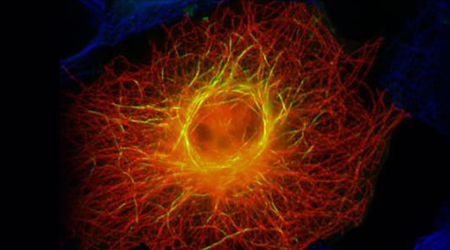
Notre Dame Integrated Imaging Facility
The Notre Dame Integrated Imaging Facility (NDIIF) is a sophisticated research core facility that houses and integrates three areas of Notre Dame imaging expertise: electron microscopy, biological imaging (in vivo imaging and optical microscopy), and histology. The NDIIF supports an interactive network of research groups, who are connected by their interest in imaging technology, and allows them to cross-fertilize ideas and form interdisciplinary collaborations. The NDIIF makes available an integrated suite of sophisticated microscopes and imaging stations that enable expert users to attack the most complex modern research problems.
The NDIIF is open to the Notre Dame research community, external academic institutions, and industry. Additionally, it is an approved Indiana Clinical and Translational Sciences Institute (CTSI) core facility, with services available to all CTSI partners.
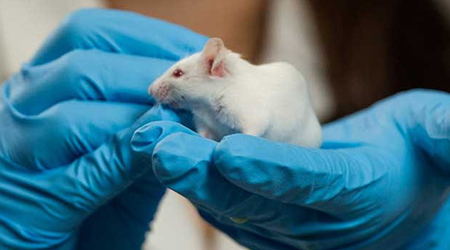
Freimann Life Science Center
The Freimann Life Science Center (FLSC) is comprised of two state-of-the-art animal facilities equipped to house a wide variety of vertebrates, including: fish, with a large zebrafish population, frogs, rabbits and rodents. More than 100 different strains of genetically altered mice are bred and maintained between the satellite facility in the Raclin-Carmichael Hall within the Indiana University School of Medicine in South Bend and the FLSC main facility. The highly trained staff are all animal care technicians who are certified through the American Association of Laboratory Animal Science or are registered veterinary technicians who together work with the attending veterinarian. In addition, the FLSC is fully accredited by the Association for Assessment and Accreditation of Laboratory Animal Care (AAALAC). Accreditation by AAALAC is on a voluntary basis and ensures an animal care facility it is operating well above the legal minimum, with accreditation site visits occurring three times a year.

Genomics and Bioinformatics Core Facility
The Genomics & Bioinformatics Core Facility (GBCF) offers comprehensive services and support for state-of-the-art 'omics' experiments and bioinformatics analysis. GBCF services are designed to provide genomics solutions and acquire data for a broad range of applications encompassing genomics (including metagenomics, cancer genomics, microbial genomics, and non-model system genomics), transcriptomics, and epigenomics research. The facility offers support for a diverse research community that spans basic biomedical research in human disease, vector disease research (arthropod vectors and parasites), and environmental genomics. Services include next-generation Illumina sequencing, ABI3730xl sequencing and fragment analysis, and a variety of RNA/DNA library construction and QC techniques. The Bioinformatics team offers additional services for standard and custom genomic analysis, and access to biocomputing resources. Consultation is available to guide experimental design, and to provide assistance in identifying appropriate technology for specific research needs. We are an approved Indiana CTSI core facility.

Zebrafish Core Facility
The Center for Zebrafish Research (CZR) at the University of Notre Dame is housed in approximately 3,000 square feet in the Galvin Life Science building. The CZR consists of eight double-sided racks and 38 single-sided racks that allow for a flexible arrangement of tanks from 1.5 to 8 liters in size. Racks are maintained on multiple, independent life-support systems to minimize a catastrophic event to the entire system. A separate room houses the zebrafish nursery. The approximate total capacity of the CZR is 120,000 adult zebrafish (one of the largest systems in the Midwest).
The CZR provides several services including the generation of ENU-induced mutants and screening of mutant phenotypes, the introduction of morpholinos into embryos and some adult tissues to assay for loss-of-function phenotypes of specific target proteins, and microinjection of DNA constructs and subsequent analysis of transgenic lines.
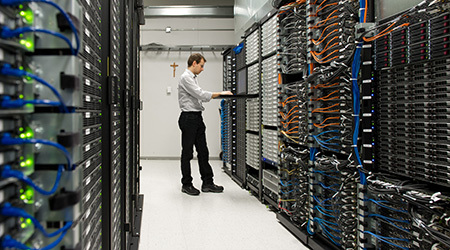
Center for Research Computing
The Center for Research Computing (CRC), an innovative and multidisciplinary research environment, is a leader in cyberinfrastructure development and in research utilizing large amounts of data and computational power, providing supercomputer resources, services, and expertise to researchers within Notre Dame and external organizations, including industry. The CRC develops computational tools that accelerate scientific inquiry and discovery. It has extensive experience in computational modeling, data analysis and management, geographic information systems, and visualization. With broad software development expertise and extensive experience managing research and development projects on many different scales, CRC collaborations range from developing advanced image recognition techniques to assist researchers in detecting drugs to modeling hurricanes to help emergency personnel prepare for the impact of major natural disasters.

Center for Environmental Science & Technology
CEST is a cooperative effort between Notre Dame’s Colleges of Science and Engineering, fostering interdisciplinary environmental research and education by providing cutting-edge analytical technologies needed to address complex environmental problems. A full-time technical support staff maintains the instruments and provides basic training on instrument use. CEST is unique in that Notre Dame faculty and students may use the instruments for class work or research without instrument-time charges.
Each year, dozens of undergraduate students use CEST as part of course work, independent study, and/or through formalized REU (Research Experience for Undergraduates) programs.
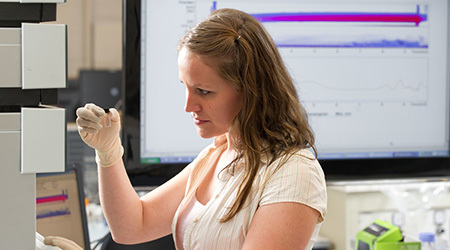
Mass Spectrometry & Proteomics
The Mass Spectrometry and Proteomics Facility (MSPF) provides modern instrumentation and expertise for the analyses of compounds ranging from small organic molecules to large biomolecules with applications in the areas of metabolomics, proteomics, and lipidomics. With instrumentation in Stepan Chemistry Hall, the MSPF is able to meet the needs of both internal and external customers, including from other academic institutions and industry. Mass Spectrometry and Proteomics is an approved Indiana Clinical and Translational Sciences Institute (CTSI) core facility.
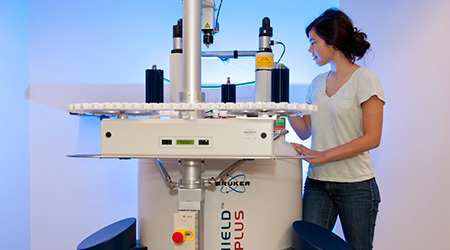
Magnetic Resonance Research Center
The Magnetic Resonance Research Center (MRRC) supports Notre Dame researchers in chemistry, biochemistry, molecular biology, chemical engineering, and related fields by providing nuclear magnetic resonance (NMR) analytical support. The MRRC is available to Notre Dame researchers, other academic institutions, and corporations off-campus.
The 700 and 800 MHz spectrometers are equipped with triple resonance cryoprobes enabling measurements of extremely dilute sample solutions or exceptionally large macromolecules. These spectrometers and the 600 instrument are dedicated mainly to studies of the molecular structures and dynamics of macromolecules, complex carbohydrates, nucleic acids, and proteins.

Molecular Structure Facility
X-ray Crystallography is the ultimate structural characterization technique. X-ray crystallography impacts all fields of chemistry and allows researchers from both organic and inorganic backgrounds to understand the three dimensional structure and connectivity of their compounds.
The Molecular Structure Facility at Notre Dame houses three single crystal and one powder diffractometer. This allows researchers rapid and timely access to a fundamental analysis of new compounds synthesized in their laboratories. In addition two high-magnification microscopes are available for optical examination of samples.
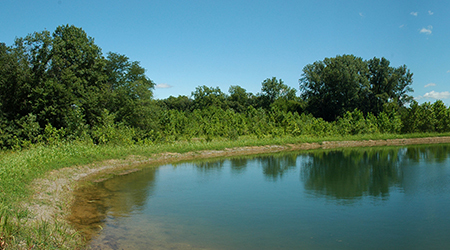
ND Linked Experimental Ecosystem Facility (LEEF)
The Notre Dame Linked Experimental Ecosystem Facility (ND-LEEF) is a research facility within the Notre Dame Environmental Change Initiative (ND-ECI). Based in South Bend’s St. Patrick’s County Park, which is five miles north of campus, ND-LEEF is a one-of-a-kind research site due to its two replicated watersheds that each contain a linked stream, pond, and wetland that can be manipulated to test ecological hypotheses. In addition to the aquatic resources, ND-LEEF hosts several shallow-groundwater monitoring wells. There are also several acres available for terrestrial research and a large gravel laydown area for mesocosm experiments. A newly constructed pavilion offers an ideal venue for education and outreach programs. ND-LEEF is available to researchers from the Notre Dame community, other academic institutions, and industry.

Museum of Biodiversity
The Museum of Biodiversity showcases the Department of Biological Sciences’ extensive collections of amphibians, fish, birds, mammals, insects, parasites, and fossils that have been collected over the last 150 years. As part of the museum, the herbarium preserves the fragile and delicate collection of dried and pressed plants of the Greene-Nieuwland Herbarium.
Rev. Edward Sorin, C.S.C., Notre Dame's founder and first president, obtained Notre Dame’s first natural history museum collection through an exchange with a physician for land Sorin held near Detroit. The display was ready for the University’s first commencement exercises in 1844 and was an attraction for local visitors. It mostly was destroyed in the 1879 fire that consumed the Main Building and Rev. John Zahm, C.S.C., was assigned responsibility for rebuilding the collections. For more than 50 years the natural history collections occupied part of the first floor and the entire second floor of the old Science Hall — now the LaFortune Student Center.
The collections moved with the Biology Department, first to Haggar Hall in 1952, and then to the newly constructed Galvin Life Sciences Center in 1971. They now occupy a portion of the first floor of Jordan Hall of Science, with a display area that faces the main Galleria.